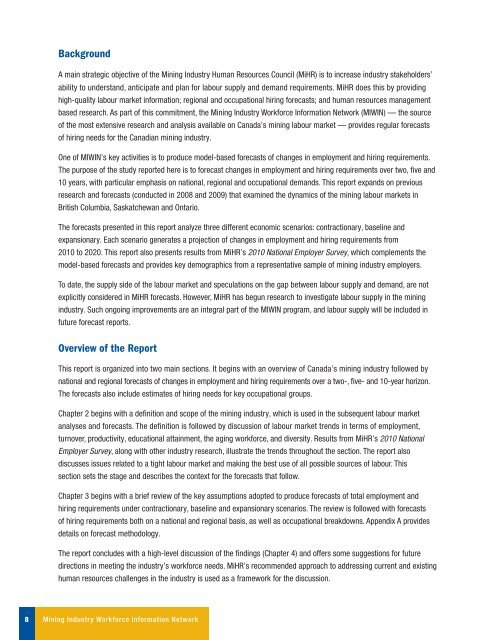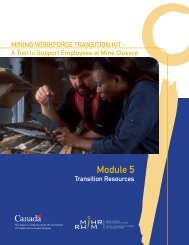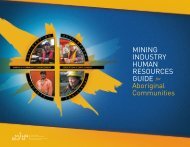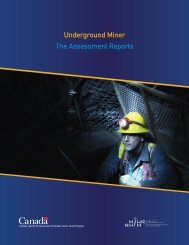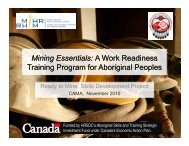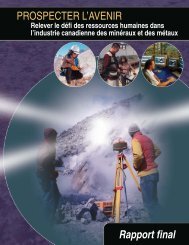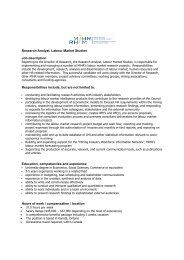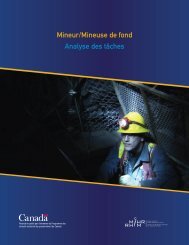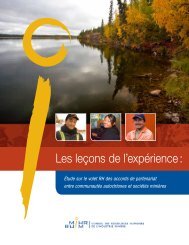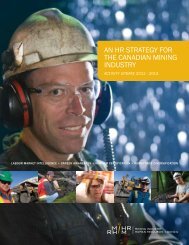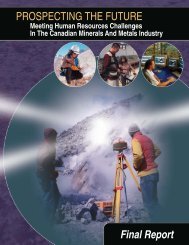Canadian Mining Industry Employment and Hiring Forecasts - MiHR
Canadian Mining Industry Employment and Hiring Forecasts - MiHR
Canadian Mining Industry Employment and Hiring Forecasts - MiHR
Create successful ePaper yourself
Turn your PDF publications into a flip-book with our unique Google optimized e-Paper software.
Background<br />
A main strategic objective of the <strong>Mining</strong> <strong>Industry</strong> Human Resources Council (<strong>MiHR</strong>) is to increase industry stakeholders’<br />
ability to underst<strong>and</strong>, anticipate <strong>and</strong> plan for labour supply <strong>and</strong> dem<strong>and</strong> requirements. <strong>MiHR</strong> does this by providing<br />
high-quality labour market information; regional <strong>and</strong> occupational hiring forecasts; <strong>and</strong> human resources management<br />
based research. As part of this commitment, the <strong>Mining</strong> <strong>Industry</strong> Workforce Information Network (MIWIN) — the source<br />
of the most extensive research <strong>and</strong> analysis available on Canada’s mining labour market — provides regular forecasts<br />
of hiring needs for the <strong>Canadian</strong> mining industry.<br />
One of MIWIN’s key activities is to produce model-based forecasts of changes in employment <strong>and</strong> hiring requirements.<br />
The purpose of the study reported here is to forecast changes in employment <strong>and</strong> hiring requirements over two, five <strong>and</strong><br />
10 years, with particular emphasis on national, regional <strong>and</strong> occupational dem<strong>and</strong>s. This report exp<strong>and</strong>s on previous<br />
research <strong>and</strong> forecasts (conducted in 2008 <strong>and</strong> 2009) that examined the dynamics of the mining labour markets in<br />
British Columbia, Saskatchewan <strong>and</strong> Ontario.<br />
The forecasts presented in this report analyze three different economic scenarios: contractionary, baseline <strong>and</strong><br />
expansionary. Each scenario generates a projection of changes in employment <strong>and</strong> hiring requirements from<br />
2010 to 2020. This report also presents results from <strong>MiHR</strong>’s 2010 National Employer Survey, which complements the<br />
model-based forecasts <strong>and</strong> provides key demographics from a representative sample of mining industry employers.<br />
To date, the supply side of the labour market <strong>and</strong> speculations on the gap between labour supply <strong>and</strong> dem<strong>and</strong>, are not<br />
explicitly considered in <strong>MiHR</strong> forecasts. However, <strong>MiHR</strong> has begun research to investigate labour supply in the mining<br />
industry. Such ongoing improvements are an integral part of the MIWIN program, <strong>and</strong> labour supply will be included in<br />
future forecast reports.<br />
Overview of the Report<br />
This report is organized into two main sections. It begins with an overview of Canada’s mining industry followed by<br />
national <strong>and</strong> regional forecasts of changes in employment <strong>and</strong> hiring requirements over a two-, five- <strong>and</strong> 10-year horizon.<br />
The forecasts also include estimates of hiring needs for key occupational groups.<br />
Chapter 2 begins with a definition <strong>and</strong> scope of the mining industry, which is used in the subsequent labour market<br />
analyses <strong>and</strong> forecasts. The definition is followed by discussion of labour market trends in terms of employment,<br />
turnover, productivity, educational attainment, the aging workforce, <strong>and</strong> diversity. Results from <strong>MiHR</strong>’s 2010 National<br />
Employer Survey, along with other industry research, illustrate the trends throughout the section. The report also<br />
discusses issues related to a tight labour market <strong>and</strong> making the best use of all possible sources of labour. This<br />
section sets the stage <strong>and</strong> describes the context for the forecasts that follow.<br />
Chapter 3 begins with a brief review of the key assumptions adopted to produce forecasts of total employment <strong>and</strong><br />
hiring requirements under contractionary, baseline <strong>and</strong> expansionary scenarios. The review is followed with forecasts<br />
of hiring requirements both on a national <strong>and</strong> regional basis, as well as occupational breakdowns. Appendix A provides<br />
details on forecast methodology.<br />
The report concludes with a high-level discussion of the findings (Chapter 4) <strong>and</strong> offers some suggestions for future<br />
directions in meeting the industry’s workforce needs. <strong>MiHR</strong>’s recommended approach to addressing current <strong>and</strong> existing<br />
human resources challenges in the industry is used as a framework for the discussion.<br />
8 <strong>Mining</strong> <strong>Industry</strong> Workforce Information Network


